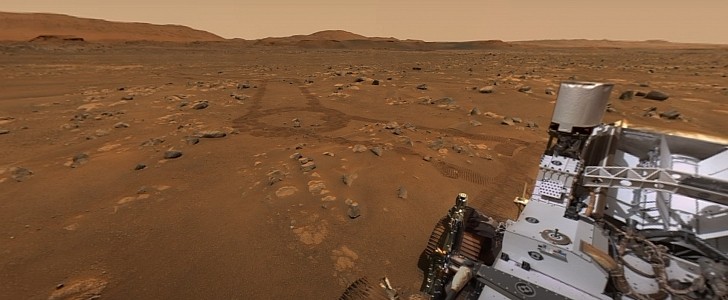Up until recently, NASA's Perseverance rover has been supporting its little buddy Ingenuity, documenting the helicopter's historic flights on Mars. But on June 1st, the rover got assigned a new job – to explore the oldest geologic features in the Jezero Crater and collect samples from the crater's floor in order to find signs of ancient microbial life.
By the time Perseverance began its new scientific campaign, it had reached several milestones on the Red Planet, including successfully testing its oxygen-producing instrument and conducting Ingenuity's demonstration flights. Its onboard cameras took over 75,000 images and recorded the first soundtracks of Mars, and captured the buzzing noise of the rotorcraft's blades.
On June 9th, NASA released a 360 video made up of 992 individual images stitched together that also contains sounds that Perseverance captured. You can actually feel as if you're standing on Mars, next to the rover, with the wind blowing on your face (the video can be found at the end of the article).
Now, for the first few weeks of its new scientific campaign, the rover will drive to a low-lying area from which it will explore some of the oldest geologic features in the Jezero Crater. In total, the mission will last a few months, during which Perseverance will investigate a 1.5-square-mile (4-square-kilometer) patch of the crater's floor.
More specifically, it will focus on two geologic units that contain ancient layers of bedrock. The rover will figure out which four spots within these units best represent the tale of Jezero Crater's early environment and geologic history.
"This area was under at least 100 meters (328 ft) of water 3.8 billion years ago. We don't know what stories the rocks and layered outcrops will tell us, but we're excited to get started.", says NASA JPL's Kevin Hand.
To learn about the geology and past habitability of the area, as well as to look for indications of ancient, microscopic life, NASA will gather the best-fitting rock and sediment samples, which a future mission will return to Earth for further research. Perseverance will also collect data and test technologies to help future human and robotic exploration of Mars.
On June 9th, NASA released a 360 video made up of 992 individual images stitched together that also contains sounds that Perseverance captured. You can actually feel as if you're standing on Mars, next to the rover, with the wind blowing on your face (the video can be found at the end of the article).
Now, for the first few weeks of its new scientific campaign, the rover will drive to a low-lying area from which it will explore some of the oldest geologic features in the Jezero Crater. In total, the mission will last a few months, during which Perseverance will investigate a 1.5-square-mile (4-square-kilometer) patch of the crater's floor.
More specifically, it will focus on two geologic units that contain ancient layers of bedrock. The rover will figure out which four spots within these units best represent the tale of Jezero Crater's early environment and geologic history.
"This area was under at least 100 meters (328 ft) of water 3.8 billion years ago. We don't know what stories the rocks and layered outcrops will tell us, but we're excited to get started.", says NASA JPL's Kevin Hand.
To learn about the geology and past habitability of the area, as well as to look for indications of ancient, microscopic life, NASA will gather the best-fitting rock and sediment samples, which a future mission will return to Earth for further research. Perseverance will also collect data and test technologies to help future human and robotic exploration of Mars.






